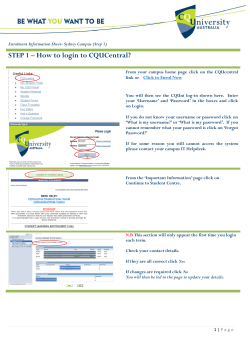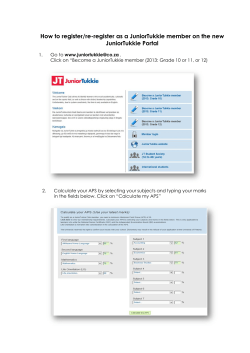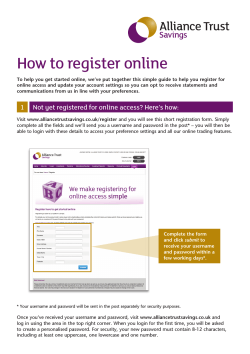
2014 User Manual for the 64GB RACHEL Pi with KA-Lite
2014 User Manual for the 64GB RACHEL Pi with KA-Lite Draft Version 1.0 Kristan J. Bakker 9/21/2014 This manual is a compilation of open source information from World Possible’s RACHEL Initiative, the Foundation for Learning Equality and their KA Lite User Manual version 0.12, Hackers for Charity, and experience from the author. This manual and RACHEL distribution is licensed under a Creative Commons AttributionNonCommercial-Share Alike 3.0 Unported License. http://creativecommons.org/licenses/by-nc-sa/3.0/ You can use and distribute this offline version of RACHEL and this manual except for any commercial purpose, like selling it in any way. You can only distribute it for free, and you must keep this attribution. Table of Contents What’s New? ............................................................................................................................................................3 Starting up the new RACHEL Pi as a server “Hot Spot”...................................................................................3 Set up the RACHEL Pi (RPi) ..............................................................................................................................3 Determine the IP address number from your system (2 Methods) ..............................................................3 Navigating RACHEL ..............................................................................................................................................6 Navigating Khan Academy Lite (KA-Lite) ..........................................................................................................7 KA-Lite Administrator........................................................................................................................................7 Login to KA-Lite as an Administrator ..........................................................................................................7 Add a Group as Administrator .....................................................................................................................7 Add Students as Administrator.....................................................................................................................8 Add Teachers (Coaches) as Administrator ..................................................................................................9 Add a Group Coach (Teacher) as Administrator ........................................................................................9 KA-Lite as a Student .........................................................................................................................................10 Sign up as a Student ......................................................................................................................................10 Login as a Student .........................................................................................................................................10 Watch a Video ................................................................................................................................................11 Practice Math Exercises (2 Methods) ..........................................................................................................12 Change Student Password ...........................................................................................................................14 KA-Lite as a Teacher/Coach .............................................................................................................................15 Login as a Teacher .........................................................................................................................................15 Get Coach Report...........................................................................................................................................15 Different Types of Coach Reports ...............................................................................................................16 Troubleshooting Rachel Pi ...................................................................................................................................19 Checking RPi and SD Card ..............................................................................................................................19 Visually confirming RPi has booted using monitor, mouse, and keyboard .............................................20 Double Check Router & IP Address ...............................................................................................................21 APPENDIX: Username & Password Record…………………………………………………………………..23 1 Please Read First To avoid damage to your RACHEL Pi System… Do not insert or pull out SD card while RACHEL Pi (RPi) is powered. This is likely to corrupt SD card. Do not insert or pull out Ethernet cable or USB devices while RPi is powered. Ethernet cable USB plug Do not grasp the silver cylinder capacitor. It is very fragile and when broken may affect RPi functioning. RPi C6 Capacitor Do not expose RPi system to dust or excessive heat. The New 64GB RACHEL Pi w/KA-Lite What’s New? The content from RACHEL and the content from KA-Lite are now conveniently combined onto one SD card. The student can access all the content from one IP address. Also new are the latest medical publications from Hesperian, the newest K-12 Textbooks from cK-12.org, and the GCF job skills training.1 The new 64GB RACHEL Pi with KA-Lite is compliments of the combined efforts of World possible - worldpossible.org, Foundation for Learning Equality – learningequality.org, and Hackers for Charity - hackersforcharity.org. One of the best additions is a new text search of the whole RACHEL repository, with a fast search engine, already pre-indexed and loaded in the server which makes search queries fly. Starting up the new RACHEL Pi as a server “Hot Spot2” Set up the RACHEL Pi (RPi) IMPORTANT: DO NOT TAKE SD CARD OUT WHILE RPi IS PLUGGED IN. ADDING OR REMOVING ANYTHING TO THE RPi WHILE POWERED CAN DAMAGE DEVICE AND/OR SD CARD STEP 1. Insert SD card into the RPi STEP 2. Connect RPi to router by connecting a cat 5 (Ethernet) cable from Ethernet port of RPi to the Ethernet LAN portal #1 on the router.3 Note: Don’t insert it into the Line portal. STEP 3. Make sure router is powered and turned on if there is an external switch STEP 4. Plug micro USB power cable into RPi and power source - preferably a solar charged battery to avoid power surges and outages that can corrupt the SD card and harm the RPi or router. Determine the IP address number from your system (2 Methods) Because the IP address is programmed to be a dynamic IP address that means that the router randomly assigns one of the available IP addresses to the RPi server. The IP address, therefore, may or may not change. In order to determine the IP address, the administrator must use one of the two methods This and more information can be found at the worldpossible.org website A hotspot in the case of RACHEL Pi is a site that offers Intranet access over a wireless local area network (WLAN) through the use of a router connected to a server, in this case the Raspberry Pi. 3 A USB Ralink Wifi Dongle may be used instead of a router. 1 2 3 described below to determine the address. The RPi can be programmed to have a static address, i.e. one that does not change, but this can only be done onsite and with the specific router being used. METHOD 1 – Using IP address scanner app on another device (e.g. tablet or laptop) STEP 1. Insert SD card into the RPi STEP 2. Connect RPi to router by connecting a cat 5 (Ethernet) cable from Ethernet port of RPi to the Ethernet LAN portal #1 on the router. Note: Don’t insert it into the Line portal. STEP 3. Make sure router is powered and turned on if there is an external switch STEP 4. Using another computer device that has WiFi (e.g. an Android tablet), go to the device settings to make sure device’s WiFi is connected to the signal from the router. Most routers have a name or sometimes a number associated with them. STEP 5. Open the app entitled FING. This app scans all IP addresses being used in the area and identifies which devices are using them. Notice in screenshot below that the RACHEL’s IP is 192.168.0.199. In order to obtain this app on your device (e.g. tablet or laptop), you must download it from the Internet through Google Play Store, https://play.google.com/store/apps/details?id=com.overlook.android.fing&hl=en STEP 6. Enter the IP address for RACHEL into the URL box on your computer devices to connect to the RACHEL content. The area circled in image below is the URL box. URL box 4 METHOD 2 – Using monitor and keyboard attached to RPi STEP 1. With RPi powered off, insert SD card into the RPi STEP 2. Connect RPi to router by connecting a cat 5 (Ethernet) cable from Ethernet port of RPi to the first Ethernet portal on the router. STEP 3. Make sure router is powered and turned on if there is an external switch STEP 4. Connect the RPi to a monitor or TV via an HDMI cable4 STEP 5. Connect a keyboard and mouse to the RPi via the 2 USB ports5 STEP 6. Plug the power cord into the RPi and watch the monitor or TV as the system reboots. Text will scroll down the monitor ending by requesting rachelpi login:. This can take a few minutes. A few lines of text above this prompt is the IP address. It will look something like 192.168.1.105. STEP 7. Enter this IP address for RACHEL into the browser’s URL box on your computer devices to connect to the RACHEL content. Note: Not all browsers work with RACHEL. Recommended as of date of writing are: Internet Explorer 9, Google Chrome 3+, Safari, Android 3+. Firefox 22+, Firefox for Android 4.1 (Jelly Bean) and Samsung phones and tablets with Android 4.0 (Ice Cream Sandwich). For updates on recommended browsers go online to http://en.wikipedia.org/wiki/HTML5_video#Browser_support Connect to TV or monitor Connect to router Connect to mouse and keyboard 5 status LED lights 4 5 If monitor or TV does not have an HDMI portal, adapters are available If using a USB WiFi dongle, use a USB port expander to plug in mouse and keyboard 5 Navigating RACHEL The RACHEL Home page is pictured below. Notice the navigation links listed below the title are HOME, ABOUT, LOCAL CONTENT, UPLOAD, info@worldpossible.org. All except the UPLOAD and worldpossible.org are accessible offline. In addition to the new content like KA-Lite and GCF LearnFree lessons in technology and math skills, all other content has been updated. Wikipedia, for example is now updated from 2008 to 2013. CK-12 texts are also all updated. Immediately below and to the right of the navigation links is the SEARCH bar. Now the content of RACHEL can be searched. 6 Navigating Khan Academy Lite (KA-Lite) KA-Lite is software that allows users without Internet access to engage with Khan Academy educational videos and exercises in completely offline settings. Users can track their progress through videos and exercises, and coaches (or teachers) can login and check up on their progress to identify in which areas the students need the most help. Some aspects of KA-Lite cannot be edited. The facility name, for example, cannot be edited so instead of having the name for your facility as in the old version, the facility name is DEMO Facility. Neither can the device be registered because the program is embedded into RACHEL. Functions that can be performed include: Adding teachers and students, adding groups, assigning a teacher and students to each group, and viewing the progress of students in those groups. Users can access KA-Lite in two ways: (1) by logging into RACHEL and selecting KA-Lite or (2) by directly entering the URL for KA-Lite into the URL box. The URL for KA-Lite is the same as that of RACHEL with a :8008 added to the end. For example – 192.168.1.199:8008 KA-Lite Administrator Login to KA-Lite as an Administrator STEP 1. Click on KA-Lite from the RACHEL homepage. STEP 2. Click on LOGIN STEP 3. Enter username: root and password: rachel (these are case sensitive) Add a Group as Administrator STEP 1. Login as with administrator username and password STEP 2. Go to ADMIN on the top navigation bar STEP 3. Under the heading (Offline) Management and Reporting Tools, select USER MANAGEMENT. See image that follows. STEP 4. Under USER LIST, select (Add a group). In order to see which groups already exist, select the gray dropdown menu box with “----“ in it. STEP 5. Under ADD A NEW GROUP, type in name of group and press CREATE GROUP, e.g. L1 Math Class. 7 Add Students as Administrator Students and coaches are the two other user types that KA-Lite supports. In order for them to be able to login, you need to create accounts for them. STEP 1. Login to KA-Lite as Administrator STEP 2. Click on ADD STUDENT on the top navigation bar STEP 3. Fill in all the information on the Add a New Student page. Be sure to write down the username and password in your records. A sample record page is in Appendix A. STEP 4. Click CREATE USER to save the new student information entered. The page should refresh, with a new message at the top saying you have successfully created a new student account. 8 Add Teachers (Coaches) as Administrator STEP 1. Login to KA-Lite as Administrator STEP 2. Click on ADD TEACHER on the top navigation bar. STEP 3. Fill in all the information on the Add a New Teacher page. Be sure to write down the username and password in your records. A sample record page is in Appendix A. STEP 4. Click CREATE USER to save the new teacher information entered. The page should refresh, with a new message at the top saying you have successfully created a new teacher account. Add a Group Coach (Teacher) as Administrator STEP 1. Login to KA-Lite as Administrator STEP 2. Go to ADMIN on the top navigation bar STEP 3. Under the heading (Offline) Management and Reporting Tools, select USER MANAGEMENT STEP 4. Under USER LIST, select gray dropdown menu box with “----“ in it and choose the UNGROUPED for a list of teachers and students who have yet to be assigned to a group. If a group is selected to which no users are assigned, the system will not go to that group. STEP 5. Select the teacher by clicking the box to the left of the user. A checkmark will appear by the teacher’s name. STEP 6. Above the list of names is a button entitled MOVE USERS TO GROUP. To the right of that button, is a dropdown menu. Click on the dropdown menu and select the group to which to assign the teacher STEP 7. Click on MOVE USER TO GROUP to assign teacher to that group. teacher example teacher 9 Alternatively, a user may be deleted on this page by clicking a check by user and clicking on the DELETE USER button. A group can also be assigned to a student or teacher when during sign up. KA-Lite as a Student Students can sign up for a user account (if the Administrator doesn’t do it for them), change their password, watch videos, and practice exercises. If students are logged in, they will earn points while watching videos and doing exercises, and track their progress in completing videos and mastering exercises. Sign up as a Student STEP 1. Open KA-Lite by entering URL of RACHEL and navigating to KA-Lite or by entering the URL of KA-Lite directly. STEP 2. Click the SIGN UP link on the top navigation bar of the KA-Lite home page. STEP 3. Fill in the information on the Sign up for an account page STEP 4. Click CREATE USER button. After successfully creating an account, the page will refresh to an Account management page with a successful login message. Login as a Student STEP 1. Open KA-Lite by entering URL of RACHEL and navigating to KA-Lite or by entering the URL of KA-Lite directly. STEP 2. Click the LOGIN link on the top navigation bar of the KA-Lite home page and enter your Username and Password. Username and password should have been provided by system administrator. 10 STEP 3. Click on the LOGIN button under the password. Watch a Video STEP 1. Open KA-Lite by entering URL of RACHEL and navigating to KA-Lite or by entering the URL of KA-Lite directly. STEP 2. Login to KA-Lite by selecting LOGIN on the top navigation bar and entering username and password STEP 3. Select WATCH in the top navigation bar STEP 4. Under the Learn by watching videos, select instructional video desired in Math, Science, Economics and Finances, or Humanities. STEP 5. Choose subcategory. STEP 6. Select specific video and watch 11 Practice Math Exercises (2 Methods) METHOD 1 – Using Knowledge Map STEP 1. After logging in, click PRACTICE on the top navigation bar STEP 2. On the Knowledge Map page, select topic and then subtopic from tree STEP 3. Select the specific type of problem to practice 12 STEP 4. On the Practice page, enter the answer either in the box or in the exercise panel, and click CHECK ANSWER button A correct answer will earn points. The harder the exercise, the more points are awarded for each correct answer. When practicing the exercises, after 10 correct answers in a row, the student has mastered the exercise. An incorrect answer or one for which a hint is requested, resets the correct answer streak and all the points for the exercise will be lost. 13 METHOD 2 – Linking to practice after watching video STEP 1. After watching a video lesson, click link on the upper right called PRACTICE THIS CONCEPT. STEP 2. On the Practice page, enter the answer either in the box or in the exercise panel, and click CHECK ANSWER button Change Student Password STEP 1. First login to KA Lite, with username and password STEP 2. Click on your username, which should appear in the top navigation of the page STEP 3. On the account management page, click on the CHANGE PASSWORD to update or edit username and password information. STEP 4. Click UPDATE USER to save the account information. 14 KA-Lite as a Teacher/Coach Coaches are users who add, manage, and track the progress of groups of students. They have access to student progress data in the form of coach reports so they can provide individualized instruction when the student needs it. Login as a Teacher STEP 1. Open KA-Lite by entering the IP address of RACHEL in the URL box and navigating to KA-Lite or by entering the IP address of KA-Lite directly. STEP 2. Click the LOGIN link on the top navigation bar of the KA-Lite home page. STEP 3. Enter Username and Password and click on the LOGIN button. Username and password should have been provided by system administrator. Get Coach Report Coach reports are visualizations of the data generated by your students. The goal of the coach reports is to put the data into an easy to understand format, so teachers can understand how students are progressing and where they need the most help. The Coach Report Page displays three types of reports. Coaches may change groups anytime in order to track different sections. STEP 1. After logging in as a teacher, the Coach Reports for Demo Facility page will open. As mentioned, Demo Facility name cannot be changed in the RACHEL Pi system. In blue font to the right of the page name will be [all groups]. Click on [all groups] for a dropdown menu of groups. STEP 2. Click on dropdown menu and then desired group for viewing coach report STEP 3. Click on one of the three types of progress report desired: Progress by topic (Table Report) Effort versus achievement Mastery over time STEP 4. Proceed according to steps for particular report described below. 15 Different Types of Coach Reports6 Understanding the TABLE REPORT [Progress by Topic] A Table Report is a grid that can show, at a high level, how students are doing in specific subjects. A coach can select which group of students for which to check progress and which subset of videos or exercises on which to see reports. This allows teachers to easily identify which students are struggling in which areas, as well as which students are doing well. Progress by Topic (Table Report) STEP 1. Select COACH from the top navigation bar (only applies to math topics) STEP 2. Click on Progress by topic image STEP 3. Select Group by clicking on [all groups] STEP 4. Select Report from the dropdown menu – Exercise or Videos STEP 5. Select Topic by clicking on the dropdown menu. The Table Report will appear. select group select report 6 This section is taken almost verbatim from KA Lite User Manual 0.12. 16 The color of the rectangles in the table indicates how that student is doing on that exercise. The following key explains the color code of the table cells: Not Attempted: The student has not attempted the subtopic. In Progress: The student has completed a few questions, but hasn’t answered 10 correct in a row yet. Completed: The student has correctly answered 10 questions in a row. Struggling: The student has answered more than 20 questions, but hasn’t answered 10 correct in a row yet. Understanding the SCATTER PLOT REPORT The Scatter Plot Report allows coaches to plot various metrics, like students’ effort, against other metrics, like students mastery. This helps coaches view data and identify high-level trends in their students’ progress. Effort versus Achievement (Scatter Plot Report) STEP 1. Click on Effort versus Achievement STEP 2. Select a Group clicking on [all groups] STEP 3. Select a Topic by clicking on topic below the VIEW REPORT button STEP 4. Click VIEW REPORT button. The report will appear STEP 5. Select the parameters for the X & Y axes on the lower left portion of the report. Select group to view 17 Understanding the TIMELINE REPORT The Timeline Report allows coaches to track individual students’ mastery of subjects over time. This is a helpful way to view student progress and helps with identifying struggling students in relation to their peers. Mastery over Time (Timeline Report) STEP 1. Click on Mastery over Time STEP 2. Select a Group by clicking on [all groups] STEP 3. Select a Topic by clicking on topic below the VIEW REPORT button STEP 4. Click VIEW REPORT button. The report will appear. STEP 5. Select a parameter for the X-axis on the lower left of the report Select group 18 Troubleshooting Rachel Pi If the system is not working, there are several possible problems and simple solutions. Many more problems are complicated. Below the simple solutions will be described. For more complicated troubleshooting, refer to RPi Wiki site online at http://elinux.org/R-Pi_Troubleshooting. The basic trouble spots include: the SD card, the RPi, and the router. Rebooting the RPi after checking all connections is the first troubleshooting step to resolving most issues with the Pi. To reboot power the RPi down and power it back up again. Checking RPi and SD Card You will be able to tell if the RPi and/or SD card are not functioning properly if the 5 colored status LED lights on the RPi are not flashing or on. The lights are next to the USB ports and can be seen if you open the RPi case. Status LED (green) Power LED (red) Full Duplex (green) Network Link (green) 100 MB Connection (amber) RPi Status LEDs If the red PWR light is not on, the RPi is not receiving power. STEP 1. Check to make sure the micro USB power adapter is properly inserted into the RPi. STEP 2. Check to make sure the battery supplying power is charged OR the power supply is on. Battery power, whether charged by the grid or solar, is the preferred method to power the RPi as it protects the system against damage from power surges and frequent power outages. 19 STEP 3. Check to make sure the battery output or power supply’s output is 5V and 1 amp. If the voltage is higher, the RPi is probably fried as it has a high sensitivity to voltage variations. If the red LED light is on but the other lights are off, the RPi is not booting up. This could be due to a malfunctioning SD card or RPi. STEP 1. With the RPi unplugged, check to make sure the SD card is making a good connection in the slot and then reboot, i.e. plug the power cord back into the RPi. STEP 2. If this is a new SD card, try a SD card you know works. If the working SD card works, your new SD card is the problem. It is possible that the disk image on the new card did not write properly. If the older SD card doesn’t work but used to work or works in another RPi, there may be a problem with the power supply or the RPi is damaged. If all lights are on but WiFi connected devices are not linking to RACHEL when IP address is entered, STEP 1. Check WiFi settings on computer device to ensure it is set to receive the router signal STEP 2. Check for correct IP address using method given on pages 2 and 3. If entering correct IP address in WiFi connected device, the router may be malfunctioning. Visually confirming RPi has booted using monitor, mouse, and keyboard STEP 1. While RPi is powered off, insert SD card into the RPi STEP 2. Connect RPi to router (in first portal) via cat 5 (Ethernet) cable STEP 3. Make sure router is powered and turned on if there is an external switch STEP 4. Connect RPi to monitor/TV via HDMI cable and HDMI port STEP 5. Connect RPi to keyboard and mouse via 2 USB ports STEP 6. Power up RPi. All LED status lights should be on or flashing on RPi next to USB ports. Watch monitor as system reboots. Text will scroll down on monitor ending by requesting rachel login: For Rachel Pi, username is pi password is rachel STEP 7. After prompt, enter username pi using the keyboard. Press ENTER. STEP 8. For Password, enter rachel. Press ENTER. 20 STEP 9. pi@rachel ~$ prompt will appear. The IP address is listed in the texts several lines above this prompt. It will say, “My IP address is 192.168.0.199” for example. STEP 10. Enter startx. The RPi desktop image will appear with a giant raspberry in the middle and several icons to the left of it. The RPi and the SD card are functioning properly Remote Desktop Image for Raspberry Pi Double Check Router & IP Address STEP 1. Double click on LXTerminal icon to left of raspberry. A small window will appear with pi@rachel - $ prompt STEP 2. Enter sudo ifconfig and press ENTER. A small window will appear with eth0 and lo left of the window and IP information including the IP address will appear on the right. The IP address the router has assigned RACHEL is to the right of eth0. See image below. 21 If no address appears, the router is not working. Shut down RPi according to steps listed below and make sure Ethernet connection from router to RPi is secure. Also check to make sure router is receiving power. Check to see if there is an external on/off switch in the back of the router and that is switched on. STEP 3. Shut down RPi by clicking on the icon that resembles a bird on the lower left of the screen. STEP 4. Click LOGOUT. This brings back the screen with text only. At the bottom of the text is a prompt pi@rachel - $ STEP 5. Enter sudo shutdown -h now after the prompt and press ENTER. The system will shut down. REMEMBER: DO NOT PUSH IN OR PULL OUT AN SD CARD WHILE THE RASPBERRY Pi IS CONNECTED TO THE POWER, AS THIS IS LIKELY TO CORRUPT THE SD CARD DATA. 22 APPENDIX USERNAME & PASSWORD RECORD ACADEMIC YEAR FROM TO ASSIGNED GROUPS LOGON INFORMATION TEACHER FIRST & LAST NAME S-1, S-2 Mrs Iyamabo USERNAME Iyamabo 1 PASSWORD passxxx ASSIGNED GROUPS S-1 LOGON INFORMATION STUDENT FIRST & LAST NAME USERNAME PASSWORD Patience Echon pechon passwww SIGNED 23
© Copyright 2025











